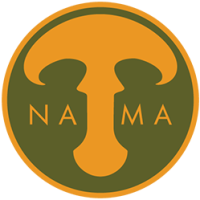Don’t live in the Pacific Northwest? Not a resident of Cascadia? Before you “swipe left,” you should consider that the significance of this guide lies well beyond the confines of Cascadian fungi (as if 4,000 species and 535,000 square miles can be considered confining). In fact, the history of mycology in North America runs through this handy tome. It is a distillation of a life’s work in mycology.
The expertise and influence of Dr. Michael Beug is enmeshed with the ascendancy of North American mycology. Beginning in 1975, Dr. Beug was part of the Pacific Northwest Key Council established by mycologist Dr. Daniel Stuntz, and mycological photographer/amateur mycologist Kit Scates Barnhart. As a member of this group from its initiation, he helped to create and field test dichotomous keys for Cascadia species. Dr. Beug is also responsible for finding over 50 previously undiscovered oak-associated Cortinarius species in Cascadia, has been the NAMA chair of its toxicology committee since 2001, and was the mentor of Paul Stamets at Evergreen College. Also contributing to this work are photos from the library of Harley and Kit S. Barnhart, which was bequeathed to Dr. Beug.
Now for the scope of the key itself. Over 900 species with more than 1,000 photos cover the area from coastal southern Alaska to central California, and inland to Idaho. This key—unlike that of historical Pacific Northwest Key Council keys—is not strictly dichotomous. That is, instead of choosing between two descriptors like “a. Has a conspicuous webby, veil” versus “b. Has no veil,” a choice between three or more descriptors may be given. This, of course, accounts for cases where more than two species show similarities, and leads to a more rapid identification; the field of choices is narrowed more quickly. This can be particularly time-saving when one happens upon a large flush of unidentified mushrooms: should one harvest them all (edible) or just pick a representative sample for the show table (not edible) and move on?
All choices are illustrated in situ, and— where necessary—with views of the stipe, cap and gills, and in stages of development. The preponderance of photos was taken by Dr. Bueg. A fair sampling from the Barnhart photo collection are included; a few are contributions of Paul Stamets. Following the illustration with its specific name is a concise list of “Comments,” which allows for a more nuanced description of characteristics than pictorial icons. Thus, for “edibility,” for example, we have “edibility not tested,” ”edible but slimy” or “too tough to eat.” Additional key distinguishing features included are taste and smell, alternative Linnean names, toxicity, geographic range including elevation, seasonality and key botanical associations.
In general, a reminder is in order regarding the utility of such a handbook to non-Cascadians: many of the included species are found in wide swaths of the North American continent. The key can be used to narrow to genus if not species. Also, the functionality of such a handbook does not depend on cellphone signal availability. Following your meander through the woods, more nuanced IDs can be made at the aforementioned Key Council downloadable online app, MycoMatch (v. 2.4, 2020) found at mycomatch.com.
Finally, the book design is well-thought-out; many useful features are included. The front inside cover includes a map while the back includes a ruler graded in both inches and centimeters. The front material has concise yet necessary guides to collecting and preparation (Do not taste large, red-pored boletes!). The only disappointment is that the cover is not more durable.
Review by Laura Juszczak, 2021


NAMA Store >